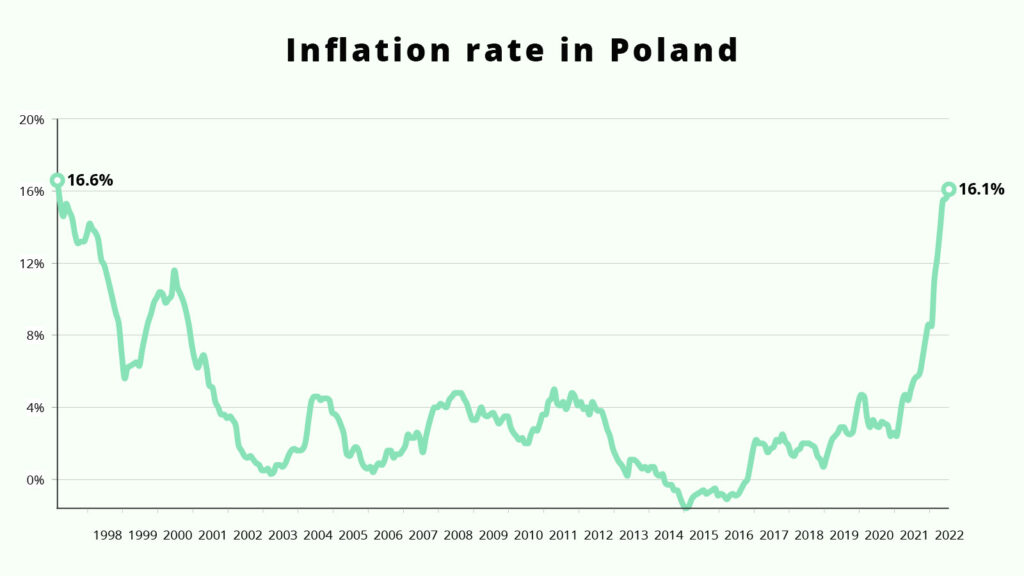The inflation rate in August reached 16.1% year-on-year in Poland, unexpectedly accelerating from 15.6% in July, with economists having forecast price growth to have begun slowing down.
The new figure, which comes from a flash estimate by Statistics Poland (GUS), a state agency, means that inflation has reached another 25-year high in Poland. It is also the highest reading for August among the European countries that have already published data for this month.

Source: Statistics Poland (GUS)
“Ouch,” tweeted analysts at mBank in response to the figure, which they pointed out contradicted the forecasters’ consensus of a slowdown in inflation and mBank’s own forecast of a stabilisation.
They noted that price growth had been driven mainly by rising energy and food costs, which went up 3.7% and 1.6% month on month respectively. However, core inflation – which excludes volatile prices such as food and energy – may also have exceeded 10% in August.
“We are now more inclined to look for a peak in food prices in 2023,” they added. “By the end of the year, inflation will not go below 16%.”
Dla wzrokowców. Wstępnie zakładaliśmy, że do końca roku ceny energii mogą rosnąć po 4% miesięcznie. Teraz bardziej jesteśmy skłonni szukać szczytu cen żywności w 2023 roku. Do końca roku inflacja nie zejdzie poniżej 16%. Pisaliśmy o 20% w I kwartale i tam jedziemy (energia). pic.twitter.com/5yPRUQ1s1A
— mBank Research (@mbank_research) August 31, 2022
Analysts at Pekao, another bank, had forecast inflation of 15.4%, 0.2 percentage points lower than in July. BOŚ Bank had predicted a figure of 15.5%, while Credit Agricole foresaw inflation falling to 15.2%.
“We’re still picking our jaws off the floor, but it looks like all the major categories surprised upwards,” said Marcin Luziński, an economist with Santander Bank Polski, quoted by financial news service Bankier.pl.
He noted that the big rise in energy costs – which was the largest such month-on-month growth this year – might have been influenced by the price of coal, which risks being in shortage this winter.
Of the 10 European countries that have already published August inflation data, price increases in Poland were by far the fastest. Slovenia and Spain are second and third, with inflation rates of 11% and 10.4% respectively, according to data published on Trading Economics website.
One of the reasons why prices in Poland have risen faster than in other European countries is the weakening of the zloty against the euro and the dollar, as well as dependence on imports of energy resources, mainly coal, oil and gas, which have become significantly more expensive in recent months.
Of the 10 European countries that have already published August inflation data, price increases in Poland were by far the fastest, according to data published on the Trading Economics website.
Today's reading of 16.1% surprised most economists in Poland. https://t.co/drQ7CkWBuJ pic.twitter.com/iE8EHb8Mf3— Alicja Ptak (@AlicjaPtak4) August 31, 2022
Inflation in Poland has been rising almost continuously since June 2021. The only exception was in February 2022, when two “anti-inflation shields” introduced by the government took effect.
In separate data released on Wednesday, the Polish statistics office also reported that the GDP growth reading for the second quarter was revised upwards from 5.3% to 5.5% year on year.
PKB za II kwartał zrewidowany w górę z 5,3 do 5,5% r/r. Bardzo ciekawa struktura wzrostu: dużo inwestycji (po danych z sektora przedsiębiorstw było to b. prawdopodobne), dużo konsumpcji prywatnej, ujemna kontrybucja eksportu netto i ostry zjazd na zapasach. pic.twitter.com/72JhAmf0II
— Analizy Pekao (@Pekao_Analizy) August 31, 2022
Main photo credit: Andrea Piacquadio / Pexels.com

Alicja Ptak is senior editor at Notes from Poland and a multimedia journalist. She previously worked for Reuters.



















